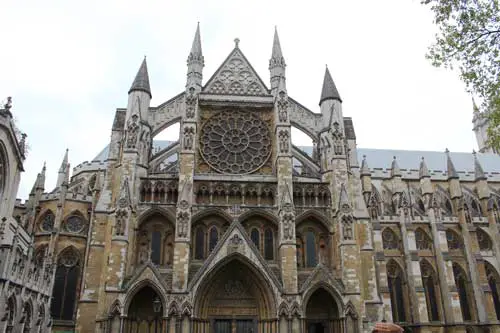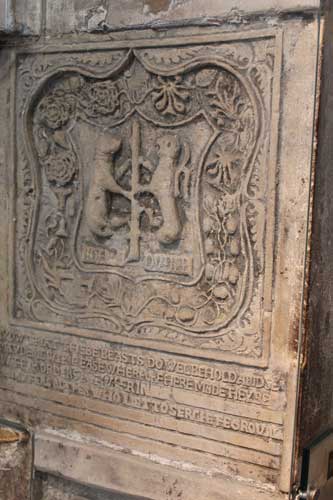 On Saturday 19th February 1547, King Edward VI rode from the Tower of London to Westminster in preparation for his coronation the next day. Chronicler and Windsor Herald Charles Wriothesley recorded:
On Saturday 19th February 1547, King Edward VI rode from the Tower of London to Westminster in preparation for his coronation the next day. Chronicler and Windsor Herald Charles Wriothesley recorded:
"The nynetenth daie of Februarie the Kinges Majestie rode from the Towre to Westminster through the cittie of London, which was rychly hanged with riche cloathes and divers pageantes, the conduites running wyne, the craftes standing in their raills, and the aldermen, the lord major riding in a crymosin velvett gowne with a rych collar of goulde, with a mase in his hand, afore the King; and, when his Majestie came where the aldermen stode, the Recorder made a proposition to his Majestie, and after the Chamberlaine gave his Majestie a purse of cloath of gould for a present from the cittie, which he thanckfullie tooke."
John Gough Nichols, in Literary Remains of King Edward the Sixth, drew on a College of Arms manuscript for his account:
"On Saturday, being the xixth day of February, aboute one of the cloke in the afternone, the Kinges royall majestie proceeded from the Tower of London, through his cytee of London, in moste royalle and goodly wyse, towards his paleys of Westminster, in the which was made dyvers and goodly provisyon for the recepte of his most royall person, as hereafter shalbe declared.
First, The strettes through all the way where the Kynge should passe were well graveled, in every place thereof, and rayled on the one syde from Grace church strete to the Lyttell Coundeth in Chepe, to th' intente that the horsses showld not slyde on the pavement, nor the people showlde not be hurt by the said horsses in the high stretes. Within these rayles stode the crafts alonge in ther order, to the Lytel Coundyth aforesaid, wheras stode the alldermen. On the other syde the stretes in many places stode prestes and clarkes, with their crosses and sensers, and in their best ornamentes, to sense the Kynge; and by all the way where the Kynge showld passe, on either syde the way, was the windowes and walles goodly garneshed with clothes of tapesetry, arras, clothe of gold, and clothe of tisshewe, with quysshyns of the same, garnyshed with stremers and banners as rychely as myght be devysed. And in many places were ordeyned goodly
pagents, and devyses, and therein goodly melody and eloquent speches of noble historyes, treating of the joyfull welcominge and recepte of so noble a Kynge, as here after more plainly shalbe declared."
Nichols goes on to give the order of the procession: The King's messengers, the King's gentlemen, amabassadors' servants, the King's trumpeters, the chaplains "without dignity", Esquires of the Body, all knights, and chaplains "of dignity". These were all walking. Then, on horseback came the gentlemen and noblemen's sons, barons, bishops, earls' sons, marquesses' sons, dukes' younger sons, earls, marquesses and dukes. Then came members of the council who were paired with foreign diplomats: the Comptroller of the Household (Sir John Gage) and the Secretary of Venice, the Treasurer of the King's house (Sir Thomas Cheney) with "one of the ambassadors of the Protestants, the King's Secretary (Sir William Petre) with another Protestant ambassador, Bishop Cox (King's almoner) with another Protestant ambassador, Sir William Paget (secretary) with "Duke Phelyppe of Almany", the Lord Admiral (Thomas Seymour) with a Scottish ambassador, the Lord Privy Seal (Lord Russell) with a Scottish ambassador, the Lord Great Master (Earl of Arundel) with "Pooley Baron de la Garde of France", the Lord Chancellor (Earl of Southampton) with the French king's ambassadors, the Archbishop of Canterbury with the Emperor's ambassadors, "Sir Percevall Hart, knyght harbenger" who bore the King's cloak and hat, gentlemen ushers, then "Garter in the Kynges cote of armes" and the Mayor of London, the sergeants of arms, then the Constable of England (Henry Grey, Marquis of Dorset) bearing the sword of state, the Earl of Warwick (John Dudley), then "the erle of Arundell, lord chamberlen, supplyinge the rome as
Earle Marshall, in the lew of the lord protector. Then a lyttell before the Kyng on the left hande, the duke of Somerset, Lord Protector."
Then came the new king, King Edward VI, "walking a lytell before his canapy, because the people might the better see his grace, his highnes being richly apparelled with a riche gowne of clothe of silver all over embrodered with damaske golde, with a girkyn of white
velvett, wrought with Venyce silver, garneshed with precious stones, as rubies and diamondes, with true-loves of pearles, a doblet of white velvet according to the same, with like precious stones and perles, a white velvet cappe garneshed with lyke stones and perles, and a pere of buskenes of white velvet. His horse caparison of crymoysyn sattyn, imbrodered with perles and damaske gold."
Edward's canopy was carried by six knights with assistants and the King was followed by his footmen. Sir Anthony Browne (Master of the Horse) "leadyng a goodly courser of honor very richly trapped", the henchmen with Sir Francis Bryan (Master of the Henchmen), the gentlemen and grooms of the Privy Chamber, the pensioners and men of arms.
According to Nichols' account, pageants included:
- Fenchurch Street - "a scaffolde riche honge with clothe of Arras, and therein dyvers singing men and chyldren, synging and playing on the regales as the Kynges highnes came by."
- The Conduit, Cornhill - goodly pagent, hanged and garnished with rich Arras, and had upon the same a proper coundyth [conduit] which ran with fayre swete wyne; and in the same were dyvers instrumentes and goodly synging ; and ij. cheldren rychly apparelled" who made speeches to the king and then sang to him.
- Cheapside - "At the Great Coundethe in Chepe were ordeyned these thenges folowing: — First, before the entree of the foresaid coundethe stode ij persons resemblynge Valentyne and wylde Urson, the one clothed with mosse and in leves, having in his hand a great clobb of yew-tree for his wepone, the other armed as a knight" who made speeches. At the end of the conduit "was paled in a rocke garnyshed with roses, gelovers [gillyflowers], and other kinde of floures, upon the which there was a sumptuous founteyne, and upon the top thereof a crowne imperyall of golde, garnished .as it stode with ryche perle and stones. Under the same were certaine springes, out of the which came plenty of wyne, red and claret, descending through pipes into the strete amongest divers sortes of people, who, by the space of vj houres, with great diligence feched it away. And nigh unto the same founteyne did stand iiij chyldren, very rychly adorned, representing Grace, Nature, Fortune, and Charity" who then gave speeches. Then there "stood viij richly apparelled ladyes, representing Sapience and the seven Sciences liberall, which declared certaine goodly speeches".
Then at the end of the conduit was a double scaffold: "There was also devised under the upper scafolde an element or heaven, with the sunn, Starrs, and clowdes very naturally. From this clowde there spred abroad another lesser clowde of white sarsenet, frenged with sylke, powdered with sterres and hemes of golde, out of the which there descended a Phenyx [phoenix, the badge of Jane Seymour] downe to the nether scafolde, where as setting herselfe upon a mount there spread forth roses white and red, gelo-flowers, and hethorne [hawthorne] bowes [ the roses and hawthorn bush symbolising Henry VIII]. After that the said Phenyx was there a lyttell, there approched a Lyon [another symbol of Henry VIII] of gold crowned, makeing semblance of amyty unto the bird, moveing his head sundry tymes, between the which familiarity as it seemed there came forth a young Lyon that had a crowne imperiall brought from heaven above, as by ij angelles, wich they sett upon his head. Then the old Lyon and the Phenix vanished away, leaving the young Lyon, being crowned, alone." Then on the "nether" scaffold was a sumptuous throne upon which a child dressed in cloth of gold and a robe of crimson satin sat, which of course represented Edward VI. The throne was "upholded with iiij other cheldrene" who represented "Regalitee", Justice, Truth and Mercy, who then made speeches. Behind the throne "the golden fleece was kept by two bulles and a serpent casting out of their mouthes flaming fire, according to the story of Jason." - The Standard in Cheap - This pageant was richly hanged in cloth of tissue and arras, and had trumpets "blowing melodiously". Here, there were more speeches.
- The Cross in Cheap - The Cross was painted and gilded, and just beyond the Cross the Mayor and aldermen received the King and presented him with a purse containing a thousand gold marks.
- The Little Conduit, Cheap - This pageant was hanged with cloth of arras and "garnished with a target of Seint George and the King's arms". There was also a depiction of Edward the Confessor with a golden lion and another of St George on horseback and a "faire mayden holding a lamb in a stryng." A child pronounced an oration in Latin and St George gave a speech in English.
- St Gregory's Church, St Paul's Churchyard - Here, there was a tightrope walker: "there was a rope as great as a cable of a ship, streched in lengthe from the battlementes of Powles steple, and with a great anker at one end fastened a little before master deane of Powles house gate. And when his Majestie approached neere the same, there came a man, a stranger [being a native of Arragon,] lying on the same rope, his head forward, casting his armes and his legges abrode, running on his brest on the said rope from the said battlementes to the grownd, as it had been an arrowe out of a bowe, and stayed on the grownd. Then he came to the Kinges majestie and kyst his foot, and so after certaine words to his highnes, departed from him again, and went upwards upon the said rope till he was come over the midst of the said churchyard, where he, having a rope about him, played certaine maystreys on the said rope, as tumbling and casting hymself from one
legg to another. Then tooke the said rope and tyed it to the cabell, and tyed himselfe by the right legg a little beneath the wryst of the fote, and hong by the one legg a certayne space, and after recovered himselfe up again with the said rope, and unknyt the knott and came downe again, which staid the kynges majestie with all the trayne a good space of time." - Great Conduit, Fleet Street - This was hanged with arras and streamers, and there was a stage where a richly apparelled child represented "Truth", accompanied by two children representing Faith and Justice. Truth greeted the King with a speech "And as sone as the Kynges grace was past there were let runn ij hogshedes of wyne to the people, take who wolde."
- Temple Bar - "The gate was paynted, and fashioned with battlementes and bottresses of dyvers colours, rychely hanged with clothe of Arras, garnyshed with xiiij standardes and flaggs, withe viij French trumpetts blowinge their trumpettes after the fashion of their countrey. And besides them a payre of regalles, and chyldren singing to the same."
Then, the procession came to Westminster, where the King retired, thanking the ambassadors "for their paynes".
Notes and Sources
- Wriothesley, Charles (1875) A Chronicle of England During the Reigns of the Tudors from AD 1485-1559, Volume 1, p182-183.
- Nichols, John Gough (1857) Literary Remains of King Edward the Sixth, Roxburghe Club, p. cclxxviii to ccxci, at https://archive.org/stream/literaryremains00clubgoog#page/n309/mode/2up



Leave a Reply